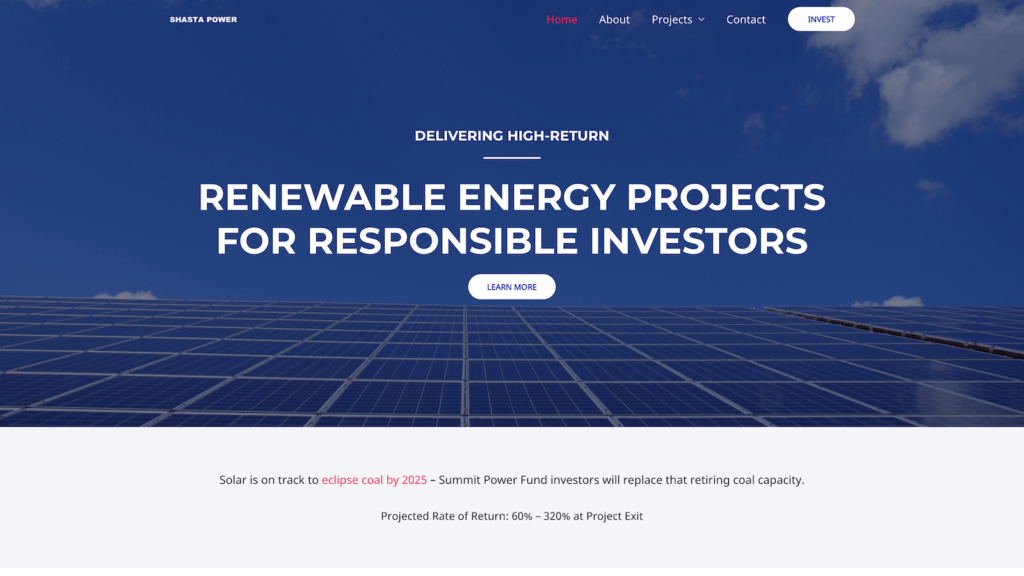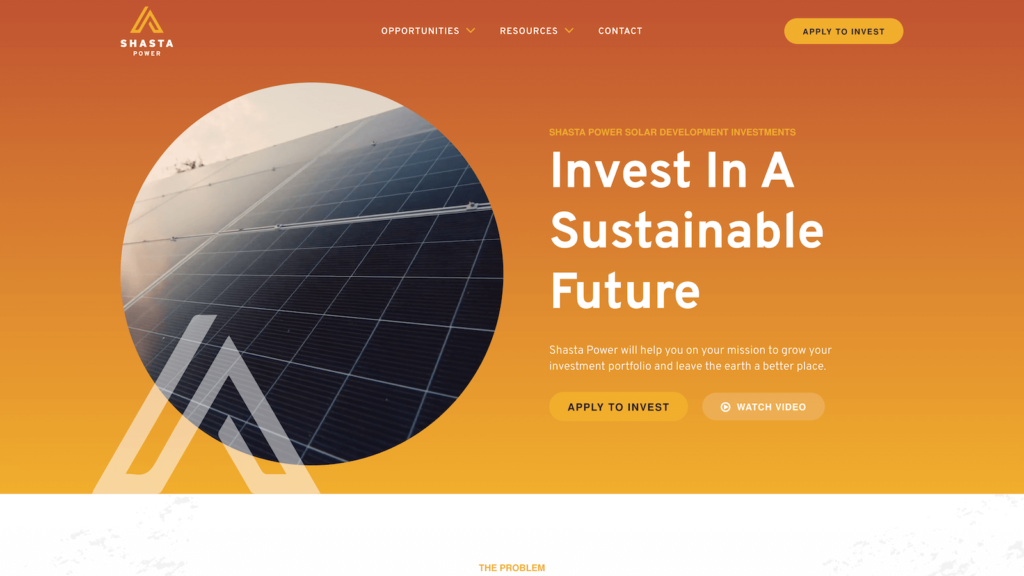investing digital STRATEGY
Impactful Digital Strategy for Impact Investing
We’ll help you plan, design, and implement secure digital systems for your impact-focused investment fund to help you scale fundraising, communicate data points with potential investors, and ensure your complete credibility.

the problem
If you’re an impact investment fund manager, you want a platform that…
“Helps you communicate with current and potential investors”
“Enhances percieved financial performance, credibility, and attracts new investors”
“Provides information on your success, investment approach, and performance data”
Additionally, we know that confidentiality and security remain paramount. Therefore, your website should balance these benefits with appropriate safeguards to protect sensitive information. A well-designed digital infrastructure can give you all these things. With Structure, you’ll get seasoned professionals doing it right.
we’ve got a plan
Create a 100% Compliant & Secure Impact Investment Platform

get a custom
DIGITAL STRATEGY

Design & build
a platform THAT WORKs

DO GOOD
and DO WELL

impact investment fund manager
Structure worked quickly against a short timeline while maintaining an impressive standard of quality.
They give me a sense of honesty and quality; they take their work seriously. They were an integral partner that didn’t upsell.
case study
Amplify Your Positive Impact Even Further
Shasta Power
digital transformation
Shasta Power built its original web platform on a budget, so Structure came on to update its user experience, online presence, and content, which helped generate $6M in funding within 12 months.


our promise
Display Digital Resilience
Enhance Responsible Investment Perception
A modern and well-designed digital infrastructure instills confidence in investors, portraying the fund as professional, transparent, and credible.
Improve the Investment Decision Experience
A user-friendly interface and intuitive navigation make it easier for investors to find information, fostering positive interactions and longer engagement.
Communicate Financial Return Clearly
A redesigned private equity website can succinctly convey your investment strategy, performance data, team profiles, and other essential information, facilitating effective communication with potential investors.
Showcase Success & Credibility
The design can highlight the investment opportunity positively, showcasing its track record and providing evidence of its capabilities.
Convince the Impact Investor with Content
A blog or insights section can position you as a thought leader by sharing industry expertise, analysis, and commentary on relevant topics.
Better Market to Social Good Investors
The new design can support marketing efforts, enabling you to communicate your unique value proposition and investment approach effectively.
Impact Investment Digital Strategy FAQs
Ensure that your experience with our team aligns with your goals and industry requirements. Here are some common questions we get and our answers.
What is Structure’s digital philosophy and approach?
A one-for-all digital solution cannot do justice to your business; you need something custom for your unique impact fund. Structure can help! We specialize in custom digital solutions for impact investors and investees, and connecting with us is easy.
Every relationship begins with a 45-minute phone call to ensure we’re the right fit for you before you sign or pay for anything.
After that, we’ll prescribe the right digital strategy package for your budget and walk you through the following phases.
- Digital Vision (Why)
- Digital Strategy (What)
- Digital Roadmap (How)
Which types of private equity funds can you design digital solutions for?
Structure helps implement and integrate digital solutions for the following types of private equity funds.
- Buyout funds
- Venture Captial (VC) funds
- Growth equity funds
- Distressed or turnaround funds
- Mezzanine funds
- Infrastructure funds
- Real estate funds
- Secondary funds
- Fund of funds
- Hedge funds
- Special situation funds
- Sector-specific funds
Does Structure work with impact-focused funds?
Impact investing is where we excel. We believe in digital and physical social impact and love to support private equity funds that use their resources to produce a social benefit.
We work with any impact investment funds:
- Environmental, Social, and Governance (ESG)
- Socially Responsible Investing (SRI)
- Impact Investing
- Sustainable Investing
- Mission Related Investment Fund
What specific digital problems do you help impact investment funds solve?
Great question! I’m glad you asked.
From a high level, we help marketing, operations, and technical leaders in impact-focused investment funds solve problems related to each of the 10 Key Components of Digital Transformation™.
Specifically, you might face one of these challenges related to each of the 10 Key Components.
Certainly! Here are specific problems an impact investment fund might want to solve in each of these areas:
1. Customer Experience
- Lack of personalized communication and engagement strategies tailored to investors’ values and preferences.
- Difficulty in providing transparent and timely reporting on social and environmental impact metrics to investors (specific to ESG investing).
- Limited accessibility and usability of online platforms for investors to track their investments and engage with the firm.
- Inconsistent communication channels and touchpoints throughout the investor journey, leading to fragmented experiences.
- Challenges in addressing investor inquiries and concerns promptly and effectively, impacting overall satisfaction and retention.
2. Data & Insights
- Insufficient data infrastructure and analytics capabilities to effectively track and measure social and environmental impact across investment portfolios.
- Difficulty in integrating data from diverse sources, such as portfolio companies, ESG rating agencies, and impact measurement tools, to provide comprehensive insights.
- Lack of standardized metrics and methodologies for evaluating impact performance, hindering comparison and benchmarking efforts.
- Inadequate tools and processes for collecting, analyzing, and reporting impact data to stakeholders in a timely and transparent manner.
- Challenges in identifying actionable insights from impact data to inform investment decisions and optimize portfolio performance.
3. Strategy & Leadership
- Unclear alignment between the firm’s impact goals and its overall investment strategy, resulting in inconsistent decision-making and resource allocation.
- Lack of buy-in and engagement from senior leadership on integrating impact considerations into investment processes and decision criteria.
- Difficulty in defining and articulating the firm’s unique value proposition and competitive advantage in the impact investing market.
- Inadequate succession planning and leadership development initiatives to ensure continuity and effectiveness of impact-driven strategies.
- Challenges in fostering a culture of innovation and adaptability to respond to evolving market trends and stakeholder expectations.
4. Technology
- Outdated or fragmented technology infrastructure inhibiting efficient data management, analysis, and reporting capabilities.
- Lack of scalable and customizable digital platforms for investor onboarding, portfolio management, and impact measurement.
- Difficulty in integrating third-party software and tools with existing systems, leading to inefficiencies and data silos.
- Inadequate cybersecurity measures to protect sensitive investor data and mitigate risks of data breaches or cyber attacks.
- Limited use of emerging technologies, such as artificial intelligence and blockchain, to enhance transparency, efficiency, and accountability in impact investing processes.
5. Operations
- Inefficient and manual processes for due diligence, investment monitoring, and impact assessment, leading to increased administrative burden and costs.
- Lack of standardized procedures and workflows for managing investment lifecycles and ensuring compliance with regulatory requirements.
- Challenges in scaling operations to support the growth of the firm and its investment portfolios while maintaining quality and effectiveness.
- Inadequate risk management practices to identify, assess, and mitigate operational, financial, and reputational risks.
- Difficulty in optimizing resource allocation and operational efficiency to maximize social and financial returns while minimizing costs and waste.
6. Culture & People
- Limited diversity and inclusion within the organization, hindering creativity, innovation, and decision-making effectiveness.
- Lack of employee engagement and alignment with the firm’s mission and values, impacting morale, productivity, and retention.
- Challenges in fostering a culture of collaboration, trust, and accountability across diverse teams and geographies.
- Inadequate training and development programs to build skills and capabilities in impact investing, ESG integration, and sustainable finance.
- Difficulty in attracting and retaining top talent with expertise in impact measurement, sustainable finance, and social entrepreneurship.
7. Organization
- Lack of clarity and alignment on organizational goals, priorities, and roles and responsibilities among different departments and teams.
- Inefficient organizational structure and decision-making processes, leading to bottlenecks, delays, and miscommunication.
- Challenges in managing organizational change and adaptation to new market dynamics, regulatory requirements, and stakeholder expectations.
- Inadequate governance mechanisms to ensure accountability, transparency, and ethical conduct throughout the organization.
- Difficulty in fostering partnerships and collaborations with external stakeholders, such as investors, portfolio companies, and industry associations, to amplify impact and achieve shared goals.
8. Marketing
- Ineffective communication strategies for articulating the firm’s impact mission, investment approach, and value proposition to target audiences.
- Limited brand visibility and awareness within the impact investing community, hindering efforts to attract investors and strategic partners.
- Challenges in crafting compelling impact narratives and storytelling that resonate with diverse stakeholders and drive engagement.
- Inadequate measurement and tracking of marketing performance metrics, such as lead generation, conversion rates, and brand sentiment.
- Difficulty in adapting marketing strategies to evolving market trends, investor preferences, and regulatory requirements in the impact investing space.
9. Cybersecurity
- Vulnerabilities in network infrastructure and software systems, exposing the firm to potential cyber threats and data breaches.
- Insufficient employee awareness and training on cybersecurity best practices, increasing the risk of human error and security incidents.
- Lack of robust cybersecurity policies and procedures for safeguarding sensitive investor information and intellectual property.
- Challenges in staying abreast of evolving cybersecurity threats and regulatory requirements in the financial services and impact investing sectors.
- Inadequate incident response and recovery plans to mitigate the impact of cybersecurity breaches and ensure business continuity and client trust.
10. Brand Management
- Difficulty in maintaining brand consistency and integrity across diverse marketing channels and touchpoints.
- Challenges in managing reputation risks and responding effectively to negative publicity or stakeholder concerns.
- Limited resources and capabilities for proactive brand management activities, such as brand monitoring, analysis, and reputation management.
- Inadequate strategies for leveraging positive brand associations and stories to differentiate the firm and attract investors and partners.
- Lack of alignment between brand messaging and organizational values, impacting brand authenticity and credibility in the impact investing space.
Our team can help you assess and address these specific problems (and more!) to help your impact investment fund enhance its operations, effectiveness, and impact in the market.
